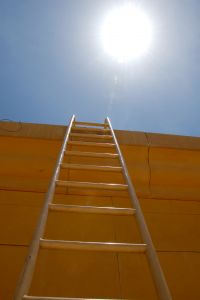 It's common for Missouri construction workers to work at elevated levels, using ladders or other equipment to reach desired heights. Sadly, many falls happen on job sites each year: fall-related injuries and fatalities happen more often in construction than in any other industry. Data from the Occupational Safety and Health Administration (OSHA) reveals that falls are the number one cause of death in construction. In 2010, 255 construction workers were killed in falls while working from heights, and over 10,000 workers were injured. The National Institute of Occupational Safety and Health (NIOSH) reports that workplace falls "constitute a considerable financial burden: workers' compensation and medical costs associated with occupational fall incidents have been estimated at approximately $70 billion annually in the United States."
It's common for Missouri construction workers to work at elevated levels, using ladders or other equipment to reach desired heights. Sadly, many falls happen on job sites each year: fall-related injuries and fatalities happen more often in construction than in any other industry. Data from the Occupational Safety and Health Administration (OSHA) reveals that falls are the number one cause of death in construction. In 2010, 255 construction workers were killed in falls while working from heights, and over 10,000 workers were injured. The National Institute of Occupational Safety and Health (NIOSH) reports that workplace falls "constitute a considerable financial burden: workers' compensation and medical costs associated with occupational fall incidents have been estimated at approximately $70 billion annually in the United States."
The frequency of workplace falls in the construction industry has prompted OSHA, in partnership with NIOSH, to develop a fall prevention campaign. This campaign is designed to "provide employers and workers with life-saving information and educational materials about working safely from ladders, scaffolds and roofs," according to an OSHA news release. Secretary of Labor Hilda L. Solis stressed that many workplace falls are preventable, provided contractors and construction workers implement fall prevention practices. "Falls are the most fatal out of all hazards in the construction industry, accounting for almost one in every three construction worker deaths," Secretary Solis said. "Our simple message is that safety pays, and falls cost."
OSHA and NIOSH have coordinated with the National Occupational Research Agenda (NORA) program to create some basic fall prevention tips. The campaign provides various materials to promote three core messages (plan, provide, and train).
• Contractors and workers can plan together, before every job, to work safely at heights.
• Contractors must provide the right equipment for working at heights, and workers need to use that equipment.
• Contractors and workers need to be trained to use the equipment and to work safely.
Multiple factors can contribute to workplace falls, including the following:
• Walking/working surfaces that are wet, cluttered, or unstable
• Unprotected edges
• Floor holes and wall openings
• Unsafely positioned ladders
• Misused fall protection/poor fall protection training
"We have often heard the old adage, 'Plan your work and work your plan,'" said R. Ronald Sokol, president and CEO of Safety Council Texas City, in a recent interview with NIOSH eNews. "This statement is the foundation of the risk management philosophy to eliminate falls from heights. Without proper planning, workers are placed in a reactive mode based on their limited knowledge plus experience and expertise. Proper planning is used to greatly limit fall exposure."
For more information about workplace fall prevention, visit StopConstructionFalls.com.

